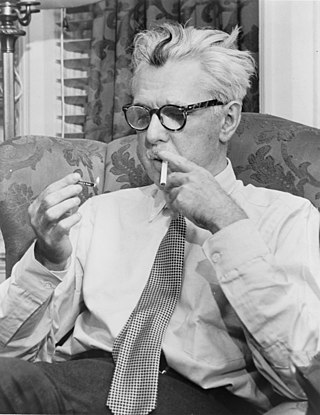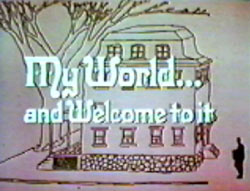
James Grover Thurber was an American cartoonist, writer, humorist, journalist and playwright. He was best known for his cartoons and short stories, published mainly in The New Yorker and collected in his numerous books.

My World ... and Welcome to It is an American half-hour television sitcom based on the humor and cartoons of James Thurber.

Filmation Associates was an American production company that produced animation and live-action programming for television from 1963 until 1989. Located in Reseda, California, the animation studio was founded in 1962. Filmation's founders and principal producers were Lou Scheimer, Hal Sutherland and Norm Prescott.

Fat Albert and the Cosby Kids is an American animated television series created, produced, and hosted by comedian Bill Cosby, who also lent his voice to a number of characters, including Fat Albert himself. Filmation was the production company for the series. The show premiered in 1972 and aired until 1985. The show, based on Cosby's remembrances of his childhood gang, focused on Fat Albert, and his friends.

Groovie Goolies is an American animated television show that had its original run Saturday mornings on CBS between 1970 and 1972. It was rebroadcast the following season on Sunday mornings. Set at a decrepit castle, the show focused on its monstrous but good-natured and mostly friendly inhabitants. Created by Filmation, Groovie Goolies was an original creation of the studio; its characters would cross over with Filmation's Archie Comics adaptations including Sabrina the Teenage Witch and The Archie Show, as well as with the Looney Tunes cast.
"The Secret Life of Walter Mitty" (1939) is a short story by James Thurber. The most famous of Thurber's stories, it first appeared in The New Yorker on March 18, 1939, and was first collected in his book My World and Welcome to It. It has since been reprinted in James Thurber: Writings and Drawings, is available on-line on the New Yorker website, and is one of the most anthologized short stories in American literature. The story is considered one of Thurber's "acknowledged masterpieces". It was made into a 1947 film of the same name, with Danny Kaye in the title role, though the film is very different from the original story. It was also adapted into a 2013 film, which is again very different from the original.

Help! ... It's the Hair Bear Bunch! is an American animated television series, created by Joe Ruby and Ken Spears and produced by Hanna-Barbera, which originally aired for one season on CBS from September 11, 1971, to January 8, 1972. Daws Butler, Paul Winchell and William Callaway voice the three bears that comprise the Hair Bear Bunch, while John Stephenson and Joe E. Ross voice Mr. Eustace Peevly and Lionel Botch, respectively, the two individuals who patrol the zoo in which the bears live. The series' producer was Charles A. Nichols, with William Hanna and Joseph Barbera directing, and Hoyt Curtin serving as the composer.

Allan John Melvin was an American actor and impressionist, who was cast in hundreds of television episodes from the 1950s to the early 1990s, often appearing in recurring roles on various series. Some of those roles and series include portraying various characters on The Andy Griffith Show, as real estate salesman Pete Dudley in My Favorite Martian, as Corporal Henshaw on The Phil Silvers Show, Sergeant Hacker on Gomer Pyle, USMC, Alice's boyfriend Sam the Butcher on The Brady Bunch, and as Archie Bunker's friend Barney Hefner on both All in the Family and Archie Bunker's Place. He has also voiced Tyrone the Bulldog, an arch-villain in the live action/animated series The Secret Lives of Waldo Kitty and was Magilla Gorilla on The Magilla Gorilla Show, as well as Drooper on The Banana Splits.
Norman Zachary Prescott was co-founder and executive producer at Filmation Associates, an animation studio he created with veteran animator Lou Scheimer.

Louis Scheimer was an American producer and voice actor who was one of the original founders of Filmation. He was also credited as an executive producer of many of its cartoons.

The Tom and Jerry Comedy Show is an American animated television series produced by Filmation for MGM Television featuring the popular cartoon duo Tom and Jerry. The show first aired on September 6, 1980 on CBS and continued until December 13 the same year. Its episodes were eventually added to syndicated Tom and Jerry packages in 1983. Episodes of the show also occasionally appeared on Cartoon Network and Boomerang.

Wheelie and the Chopper Bunch is an American animated television series, produced by Hanna-Barbera, which originally aired for one season on NBC from September 7 to November 30, 1974. The show aired for 13 half-hour episodes.

Will the Real Jerry Lewis Please Sit Down is a 1970 animated showcase for various caricatured Jerry Lewis characters, all based on characters from the 1965 film The Family Jewels, and styled in a fashion similar to Archie's TV Funnies and the Groovie Goolies. The title is a variant of the deciding question on the game show To Tell the Truth: "Will the real __________ please stand up?" Like most 1970s-era Saturday morning cartoon series, Will the Real Jerry Lewis Please Sit Down contained an adult laugh track.

The New Adventures of Gilligan is an American Saturday morning animated series produced by Filmation, which aired on ABC during the 1974–75 seasons. The show was based on the 1964–67 sitcom Gilligan's Island. A few years later, Filmation produced a sequel, Gilligan's Planet.
"The Secret Life of Walter Mitty" is a 1939 short story by James Thurber. It may also refer to:

Uncle Croc's Block is an hour-long live-action/animated television series. It was produced by Filmation, and broadcast on ABC in 1975–76.

Andy Mangels is an American science fiction author who has written novels, comic books, and magazine articles, and produced DVD collections, mostly focusing on media in popular culture. As an openly gay man, he has been a longtime advocate for greater visibility of gay and lesbian characters in various media, especially comics, including the coordination and moderation of the annual "Gays in Comics" panel for Comic Con International since it was begun in 1988. He is the founder of an annual "Women of Wonder Day" event, which raised over $136,000 in funds for domestic violence shelters and related programs during its seven-year run. As of 2011 he has had three books on the USA Today "best-selling books" list.
Daffy Duck and Porky Pig Meet the Groovie Goolies is a 1972 animated one-hour TV-movie that was aired on December 16 as an episode of the anthology series The ABC Saturday Superstar Movie. In this Filmation-produced movie, Daffy Duck, Porky Pig, and other Looney Tunes characters interact with the characters from the Filmation series Groovie Goolies.
Waldo is a masculine given name. It derives from the Anglo-Saxon name Waltheof. It may refer to:
James Francis Ryan was an American screenwriter in the DePatie–Freleng Enterprises, also the Filmation studios and Hanna–Barbera.














